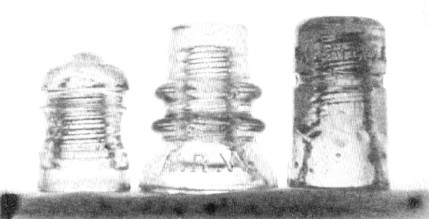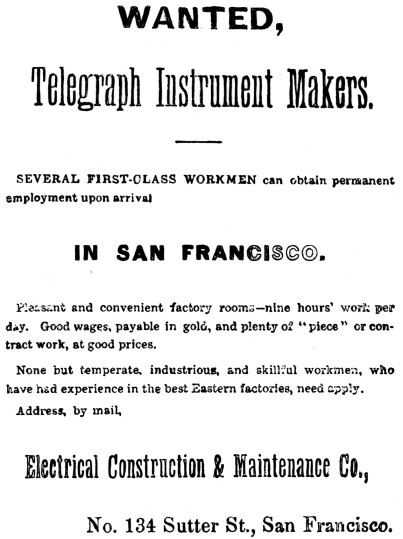Patent Pages
by Ray Klingensmith
Reprinted from "INSULATORS - Crown Jewels of the Wire", July 1978, page 7
THE CAUVET PATENT
Ever since the first telegraph lines in this country were built in the
1840's, one problem has faced telegraph engineers. That problem is line
insulation. In the early years, many crude and unsatisfactory attempts were made
in creating insulators. Once a successful form was developed, there still
remained the problem of fastening these "knobs" to poles or buildings,
etc. Widely in use in the 1840's - 1860's were the "threadless" types.
These could be forced onto iron or wood pins, sometimes cemented to said pins to
prevent their coming loose and "floating".
On July 25, 1865, Louis A.
CAUVET was issued a patent for what I feel was the most important and successful
insulator patent of all times. It was for an internally screw threaded insulator
and matching screw threaded rod or pin. This invention received widespread use
and has survived for over 100 years.

Three early threaded items
From left to right: The base embossed N.E. TEL & TEL CO.,
CD 135.5 ERW, EC&M with button on
front.
Cauvet was from New York City, being listed at 75 1/2 New Street. Being from
New York City, it was only a matter of time before he confronted The
Brookfields, who operated a glass factory. That invention probably made
Brookfield what it was in later years. It makes one wonder how large a company
Brookfield would have been if it were not for Cauvet's patent.
By the early 1870's, this idea of securing insulators was widely accepted,
and other types were being abandoned. I feel the threadless was used later than
most collectors think. The threaded units no doubt became very popular in a
short period of time, but I think the threadless were produced in the
1870's, not only as replacement items, but for regular use by those unaware of
Cauvet's idea, or by those who liked the "old way". Production of
threadless probably ceased by 1880.
Several insulator or glass companies made use of Cauvet's patent in the years
following 1865. I won't attempt to make a list of these companies using the
"threaded pin" idea, as it is an endless task. I've included a copy of
an early ad which was put out by EC&M. It might be of interest to
collectors. The EC&M's were one of the many early units to be made under
Cauvet's patent.

UPDATE ON PATENTS
Oops! I did it! Now I'm even with Jack Tod. I made a mistake (one). I've
tried to keep everything as factual as possible in the articles and not use any
assumptions. In the Combination Safety/Safty article I stated the Telephony
ad was from circa 1900. Circa means approximate. I assumed Telephony
was a periodical publication and that it was dated. In writing to Larry Harmon,
who originally sent the Combination Safety ad (which appeared in Telephony)
to Crown Jewels, he stated he didn't own the Telephony
publication. So I couldn't pinpoint it as a definite date of 1900. In checking
my notes on Brookfield recently, I have noticed Brookfield's offices moved to 2
Rector Street in 1908. If that is correct, then the Combination Safety ad
wouldn't have appeared until at least that year. At any rate, the idea behind
all this is that the Combination Safety may not have been advertised as long as
I thought, and I felt maybe some of the readers would like to make note of it in
their June issue.
Thanks to the Branhams for sending the EC&M ad, and to Wendell Hunter who
sent information on a patent issued to Amasa Stone in 1855 for an insulator with
a threaded interior. It is a little similar to the Cauvet patent, but is
different enough to allow Cauvet to have also received a patent. I would have
included this information in the article, but Glenn Drummond previously stated
he is going to send the same info to C.J., so no need for my repeating
his information.
| 